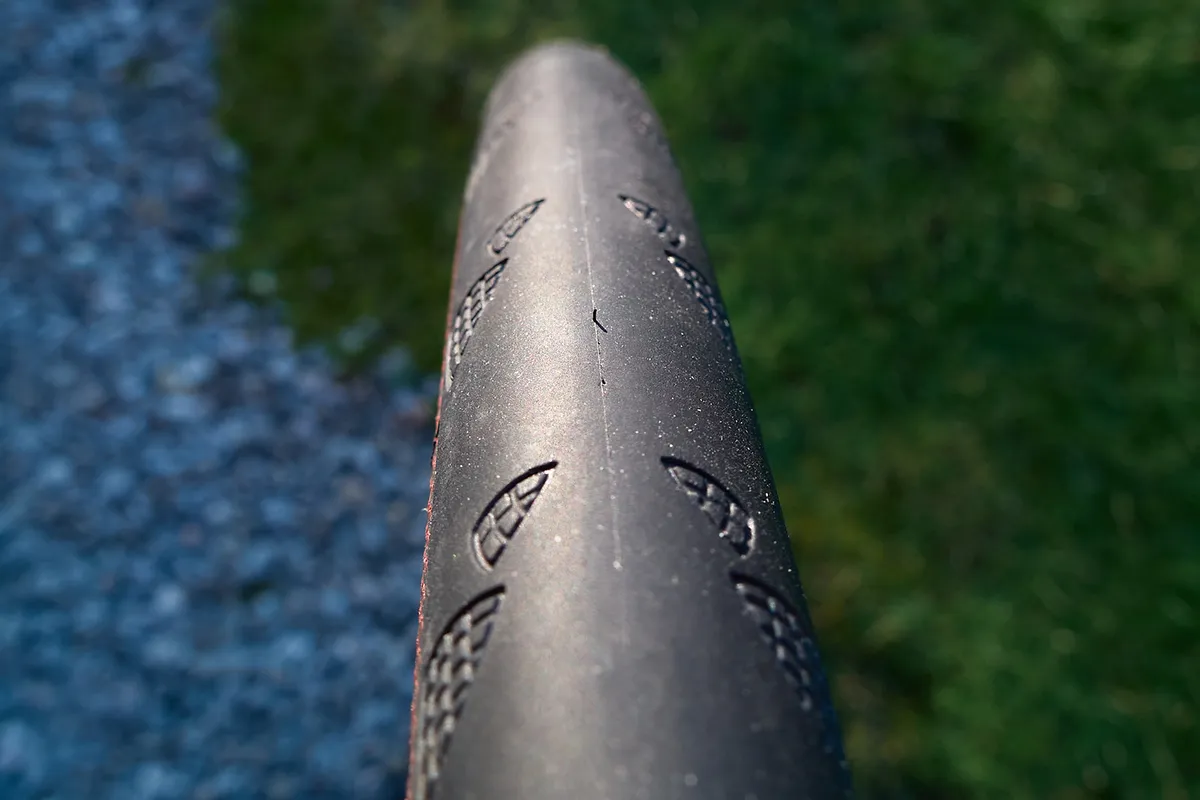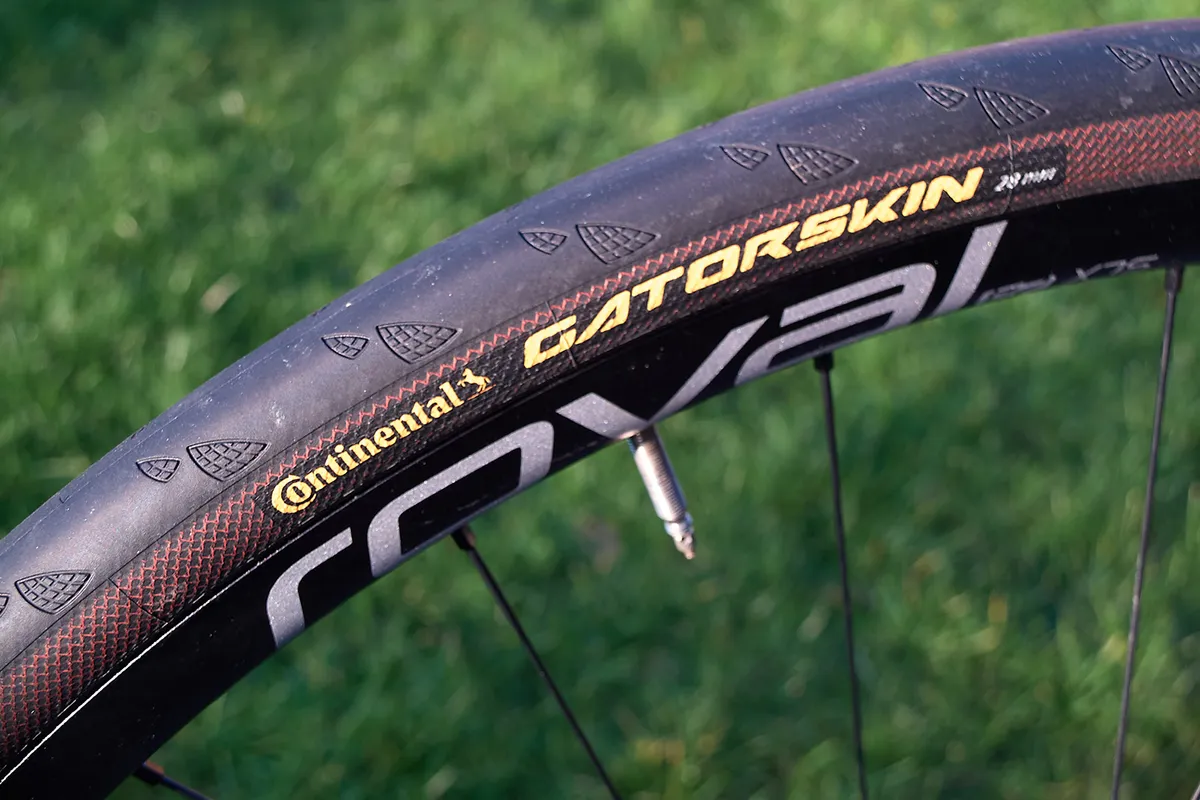Continental bills the Gatorskin as a high-mileage winter training tyre for tough conditions.
The Gatorskin is a very common sight on a large number of low-price and mid-range road bikes. Moreover, it’s a popular choice on the rims of local club riders and winter or commuter bikes the world over.
In testing, its demonstrable blend of reliability and performance tells me the Gatorskin remains popular for good reason.
Continental Gatorskin specification and details
The Gatorskin can be bought with a folding Kevlar bead (as tested here) for £44.95 a tyre, or for around £5 less it comes with a rigid wired bead instead.
It’s available in four widths for 700c wheels (23, 25, 28 and 32mm), and is built on a 3-ply, 180 TPI carcass.
Covering all bases, it’s also available for 650C, 26in and 27x 1 ¼in wheel sizes.
Continental includes the bead-to-bead DuraSkin mesh protective layer for additional sidewall protection, which offers the tyre’s characteristic red-brown shade, as also seen in the more performance-oriented Grand Prix 4 Season tyre.
The black tread is formed from natural rubber, with a ‘PolyX Breaker’ polyester fibre puncture protection layer under the core rolling area of the tyre.
Continental recommends the tested 700 x 28c Gatorskin is inflated to 95psi, with a maximum of 116psi. That’s much higher than we’ve become used to, although expectations are often influenced by tubeless specifications – remember, the Gatorskins can only be run with inner tubes.
The tyres on test weighed in beneath the claimed weight at 276g apiece.
Continental Gatorskin performance

I found the Gatorskins to be immediately user-friendly, proving easy to slip on to my test rims with minimal effort.
Fitted to a rim that was 20mm wide internally, the 28mm tyres measured 29.5mm wide and 26.5mm tall. This creates a shallow, nicely rounded inflated profile.
The rubber is generally smooth, but with small triangles interspersed every 38mm around the shoulders. Those triangles have 13 tiny knobs cut into them.
Another ring of smaller, similar triangles sits inside them, and jointly they create more mobile sections of tread. These are intended to increase cornering grip – enabling the tyre to deform better – and I found they provided lots of it.
With the thin DuraSkin mesh layer offering much of the puncture protection, plus the PolyX Breaker (rather than a relatively thick, solid puncture-resistant layer beneath the tread), the Gatorskin is impressively light.
Allied to the 180 TPI carcass, the Gatorskin feels surprisingly supple, lively and responsive.
Accelerating away from junctions or climbing stiff gradients feels positive. This should justify the use of wheels that aren’t at the very bottom of a brand’s range.
To be clear, the road ‘feel’ and suppleness while cornering are the same whichever wheelset you choose. However, with something a little lighter, you’re able to exploit the tyres’ ability to be ridden quickly.
Grip from the natural rubber tread seems maximised by the tyre’s profile, and the mainly slick tread surface copes admirably with typical winter muck on uneven roads.
It has so far been unaffected by grit and gravel. There have been no nicks or cuts, even after being run at lower pressures (I weigh 74kg) than the very high 95 to 116psi Continental recommends.
These recommendations should be followed, but running a 28c tyre at 95psi negatively impacts the natural comfort the tyre could provide versus running it 10 to 15psi lower, for example.
Firm braking always feels composed, with ample grip and sufficient sidewall rigidity offering a consistent platform.
Wear hasn’t been a factor in the time I’ve spent with the Gatorskin tyre, but the handy tread wear indicator depressions in its surface will leave you in no doubt as to when it’s time to swap to a new set.
Although the Gatorskin is often billed as a hardy winter tyre, I’ve found it surprising how much speed, grip and road feel it provides.
So far, I can’t fault its puncture protection or wear rate either. In a single package, that makes the Gatorskin hard to fault.
Continental Gatorskin bottom line

There’s a reason the Gatorskin is so popular. It has a reputation for an enticing combination of ride quality, flat protection and durability – with a leaning towards the latter.
My testing has shown this to be well-founded, backed up by the opinions of the wider BikeRadar testing team.
There are few tyres that give as much riding confidence while offering such strong protection against punctures as the Gatorskin.
Product
| Brand | continental |
| Price | 52.00 EUR,45.00 GBP,68.00 USD |
| Weight | 276.0000, GRAM (700 x 28c) - claimed weight: 280g, actual weight: 276g |
Features
| br_TPI | 180 |
| Features | Poly X Breaker, Duraskin, 3 ply, Tread Wear Indicator |
| br_tyreSizes | 700 x 23c, 700 x 25c, 700 x 28c, 700 x 32c |
